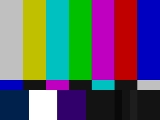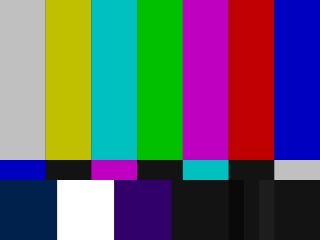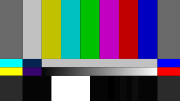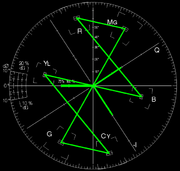
SMPTE color bars
Encyclopedia



Television
Television is a telecommunication medium for transmitting and receiving moving images that can be monochrome or colored, with accompanying sound...
test pattern
Test card
A test card, also known as a test pattern in North America and Australia, is a television test signal, typically broadcast at times when the transmitter is active but no program is being broadcast...
, and is most commonly used in countries where the NTSC video standard
NTSC
NTSC, named for the National Television System Committee, is the analog television system that is used in most of North America, most of South America , Burma, South Korea, Taiwan, Japan, the Philippines, and some Pacific island nations and territories .Most countries using the NTSC standard, as...
is dominant, such as those in North America
North America
North America is a continent wholly within the Northern Hemisphere and almost wholly within the Western Hemisphere. It is also considered a northern subcontinent of the Americas...
. The Society of Motion Picture and Television Engineers
Society of Motion Picture and Television Engineers
The Society of Motion Picture and Television Engineers The Society of Motion Picture and Television Engineers The Society of Motion Picture and Television Engineers (SMPTE , founded in 1916 as the Society of Motion Picture Engineers or SMPE, is an international professional association, based in...
(SMPTE) refers to this test pattern as Engineering Guideline EG 1-1990. The components of this pattern are a known standard
Standardization
Standardization is the process of developing and implementing technical standards.The goals of standardization can be to help with independence of single suppliers , compatibility, interoperability, safety, repeatability, or quality....
, so comparing this pattern as received to that known standard gives video engineers an indication how an NTSC video signal has been altered by recording or transmission, and thus what compensation needs to be applied to that signal to bring it back to original condition. The pattern is also used for setting a television monitor or receiver to reproduce NTSC chrominance
Chrominance
Chrominance is the signal used in video systems to convey the color information of the picture, separately from the accompanying luma signal . Chrominance is usually represented as two color-difference components: U = B' − Y' and V = R' − Y'...
and luminance information correctly. Originally conceived in the 1970s by Al Goldberg of CBS Laboratories
CBS Laboratories
CBS Laboratories or CBS Labs was the technology research and development organization of CBS...
, and previously categorized by SMPTE as ECR 1-1978, the development of this test pattern was awarded an Engineering Emmy in 2001-2002.
An updated version of SMPTE color bars, developed by the Japanese Association of Radio Industry and Businesses as ARIB STD-B28 and standardized as SMPTE RP 219-2002, is used to test both 4×3 standard definition and 16×9 high-definition
High-definition television
High-definition television is video that has resolution substantially higher than that of traditional television systems . HDTV has one or two million pixels per frame, roughly five times that of SD...
video signals.
Usage
In an SMPTE colorColor
Color or colour is the visual perceptual property corresponding in humans to the categories called red, green, blue and others. Color derives from the spectrum of light interacting in the eye with the spectral sensitivities of the light receptors...
bar image
Image
An image is an artifact, for example a two-dimensional picture, that has a similar appearance to some subject—usually a physical object or a person.-Characteristics:...
, the top two-thirds of the television picture contain seven vertical bars of 75% intensity. In order from left to right, the colors are gray, yellow
Yellow
Yellow is the color evoked by light that stimulates both the L and M cone cells of the retina about equally, with no significant stimulation of the S cone cells. Light with a wavelength of 570–590 nm is yellow, as is light with a suitable mixture of red and green...
, cyan
Cyan
Cyan from , transliterated: kýanos, meaning "dark blue substance") may be used as the name of any of a number of colors in the blue/green range of the spectrum. In reference to the visible spectrum cyan is used to refer to the color obtained by mixing equal amounts of green and blue light or the...
, green
Green
Green is a color, the perception of which is evoked by light having a spectrum dominated by energy with a wavelength of roughly 520–570 nanometres. In the subtractive color system, it is not a primary color, but is created out of a mixture of yellow and blue, or yellow and cyan; it is considered...
, magenta
Magenta
Magenta is a color evoked by light stronger in blue and red wavelengths than in yellowish-green wavelengths . In light experiments, magenta can be produced by removing the lime-green wavelengths from white light...
, red
Red
Red is any of a number of similar colors evoked by light consisting predominantly of the longest wavelengths of light discernible by the human eye, in the wavelength range of roughly 630–740 nm. Longer wavelengths than this are called infrared , and cannot be seen by the naked eye...
, and blue
Blue
Blue is a colour, the perception of which is evoked by light having a spectrum dominated by energy with a wavelength of roughly 440–490 nm. It is considered one of the additive primary colours. On the HSV Colour Wheel, the complement of blue is yellow; that is, a colour corresponding to an equal...
. This sequence runs through all seven possible combinations that use at least one of the three basic color components of green, red, and blue, with blue cycling on and off between every bar, red cycling on and off every two bars, and green on for the leftmost four bars and off for the rightmost three. Because green contributes the largest share of luminance, followed by red, then blue, this sequence of bars thus appears on a waveform monitor
Waveform monitor
A waveform monitor is a special type of oscilloscope used in television production applications. It is typically used to measure and display the level, or voltage, of a video signal with respect to time....
in luminance mode as a downward staircase from left to right. The graticule
Graticule
Graticule may refer to:* An oscilloscope graticule scale* Another name for the reticle pattern in an optical instrument* The grid used in the Geographic coordinate system...
of a vectorscope
Vectorscope
A vectorscope is a special type of oscilloscope used in both audio and video applications. Whereas an oscilloscope or waveform monitor normally displays a plot of signal vs. time, a vectorscope displays an X-Y plot of two signals, which can reveal details about the relationship between these two...
is etched with boxes showing the permissible regions where the traces from these seven bars are supposed to fall if the signal is properly adjusted.
Below the main set of seven bars is a strip of blue
Blue
Blue is a colour, the perception of which is evoked by light having a spectrum dominated by energy with a wavelength of roughly 440–490 nm. It is considered one of the additive primary colours. On the HSV Colour Wheel, the complement of blue is yellow; that is, a colour corresponding to an equal...
, magenta
Magenta
Magenta is a color evoked by light stronger in blue and red wavelengths than in yellowish-green wavelengths . In light experiments, magenta can be produced by removing the lime-green wavelengths from white light...
, cyan
Cyan
Cyan from , transliterated: kýanos, meaning "dark blue substance") may be used as the name of any of a number of colors in the blue/green range of the spectrum. In reference to the visible spectrum cyan is used to refer to the color obtained by mixing equal amounts of green and blue light or the...
, and white
White
White is a color, the perception of which is evoked by light that stimulates all three types of color sensitive cone cells in the human eye in nearly equal amounts and with high brightness compared to the surroundings. A white visual stimulation will be void of hue and grayness.White light can be...
castellations. When a television receiver is set to filter out all colors except for blue, these castellations, combined with the main set of color bars, are used to properly adjust the color controls; they appear as four solid blue bars, with no visible distinction between the bars and the castellations, if the color controls are properly adjusted.
The bottom section of the test pattern contains a square of saturated (100% intensity) white and a rectangle of saturated (7.5% intensity) black, for use in setting the luminance range. More modern versions of the pattern feature a "pluge pulse." The pluge (short for "Picture Line-Up Generation Equipment") pulse is positioned within the black rectangle, below the red bar (it is present in the illustration but may be hard to see). It comprises three small vertical bars, a rightmost one with intensity just above the saturated black level, a middle one with intensity exactly equal to saturated black, and a leftmost one with intensity just below saturated black (or "blacker than black"). The pluge pulse aids in adjusting the bottom of the luminance range to avoid either washing out the black tones into grays or collapsing picture information into the signal clipping that occurs a small distance below the saturated black level (known as "crushing the blacks"). When a monitor is properly adjusted, the rightmost pluge bar should be just barely visible, while the left two should appear completely black. Also in the bottom section are two sections that contain -Inphase and +Quadrature signals (see YIQ
YIQ
YIQ is the color space used by the NTSC color TV system, employed mainly in North and Central America, and Japan. It is currently in use only for low-power television stations, as full-power analog transmission was ended by the U.S. Federal Communications Commission on 12 June 2009...
), centered on black level and having the same gain as the color burst signal; these show up on the pattern as a square of very dark blue, and a square of very dark purple. On a vectorscope, they appear as two short lines ninety degrees apart. These are used to ensure that the television receiver is properly demodulating the 3.58 MHz color subcarrier portion of the signal. The vectors for the -I and +Q blocks should fall exactly on the I and Q axes on the vectorscope if the chrominance signal is demodulated properly.
These bars give rise to the former portion of the casual term, "bars and tone". Typically, a television network
Television network
A television network is a telecommunications network for distribution of television program content, whereby a central operation provides programming to many television stations or pay TV providers. Until the mid-1980s, television programming in most countries of the world was dominated by a small...
, TV station, or other originator of video programming transmits SMPTE color bars together with a continuous 1000 Hz
Hertz
The hertz is the SI unit of frequency defined as the number of cycles per second of a periodic phenomenon. One of its most common uses is the description of the sine wave, particularly those used in radio and audio applications....
audio
Audio frequency
An audio frequency or audible frequency is characterized as a periodic vibration whose frequency is audible to the average human...
tone
Pitch (music)
Pitch is an auditory perceptual property that allows the ordering of sounds on a frequency-related scale.Pitches are compared as "higher" and "lower" in the sense associated with musical melodies,...
before sending program material, in order to assert ownership of the transmission line or medium, and so that receiving stations and intermediary telecommunications providers may adjust their equipment. Likewise, producers of television programs typically record "bars and tone" at the beginning of a videotape or other recording medium so that the playback equipment can be calibrated
Calibration
Calibration is a comparison between measurements – one of known magnitude or correctness made or set with one device and another measurement made in as similar a way as possible with a second device....
. Often, the name or callsign of the TV station, other information such as a real-time clock, or another signal source is graphically superimposed over the bars.
An alternate form of color bars is the 100% Color Bars pattern, or RGB pattern, which consists of eight vertical bars of 100% intensity, and does not include the castellation or luminance patterns. Like the SMPTE standard ("75%") pattern, the color order is white, yellow, cyan, green, magenta, red, and blue, but with an additional column of saturated black. This pattern is used to check peak color levels and color saturation as well as color alignment. The 100% pattern is not as common or as useful as the SMPTE standard 75% pattern, but many pieces of test equipment generate both patterns, and can be selected to generate either one. Many professional cameras can be set to generate a 100% pattern for calibration to broadcast or recording equipment, especially in a multi-camera installation where all camera signals must match. There is another 75% pattern that consists of the same eight columns as the 100% pattern, but at 75% intensity. This pattern is very seldom used.
Although color bars were designed to calibrate analog NTSC equipment, they remain widely used within modern digital television facilities. All display monitors use some form of voltage to illuminate or activate a level of opacity in a pixel. Using color bars allows video, RGB, LCD, and Plasma displays, as well as duplication, television and webcast facilities, to maintain the intended chroma and luminance levels.
In the 1970s and early 1980s, the color bars were often broadcast by local television stations during special "color check" segments. For example, CFQC-TV
CFQC-TV
CFQC-DT is a Canadian television station, serving Saskatoon, Saskatchewan. The station is a CTV Television Network affiliate which can be seen over-the-air on digital channel 8, on local cable and via satellite on Bell TV Channel 249 and Shaw Direct Channel 378 on Classic channel...
in Saskatoon, Saskatchewan preceded each nightly newscast with "Color Check", which began with the SMPTE color bars as an announcer identified the colors of the vertical bars encouraging viewers to adjust their TV color settings to make sure the colors were "well separated" and matched the description, after which a photograph (later video footage) of a woman's face was broadcast for a few moments, allowing viewers to adjust their TV color settings further.
See also
- China Girl (film term)China Girl (film term)China Girl is a descriptive phrase in the motion picture industry referring to an image of a woman accompanied by color bars that appears for a few frames in the reel leader. A "China Girl" was used by the lab technician for calibration purposes when processing the film...
- Indian Head test cardIndian Head test cardThe Indian Head Test Pattern was a black and white television test pattern which was introduced in 1939 by RCA of Harrison, New Jersey as a part of the RCA TK-1 Monoscope...
- 2-pop2-popUsed in television production and filmmaking post-production, a 2-pop is a 1 kHz tone that is one frame long and placed 2 seconds before the start of program. It is a simple and effective method of ensuring synchronization between sound and picture in a video or film.A 2-pop is typically placed at...

